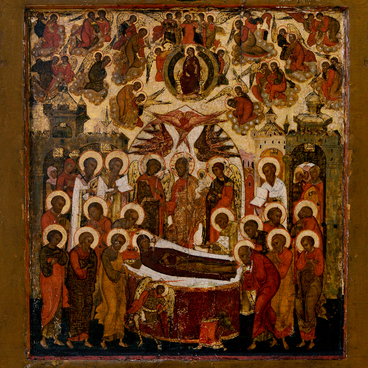The MandYlion is one of the most revered icons in Christianity, which is considered the first image of Jesus Christ. Its history goes back to the events of the Savior’s earthly life, but the artifact with which it was connected has been lost a long time ago. Russian tradition refers to it as “Ubrus, ” which is a cloth upon which an image of the face of Jesus had been imprinted.
In medieval Russia, the Mandylion was one of the main relics. The face of Christ was on the banner of the Russian army. It can be seen on the Novgorod icon of the 12th century from the Tretyakov Gallery and in the works of the 17th-century icon painter Simon Ushakov. The collection of the Novosibirsk State Art Museum has the Mandylion created in the 18th century.
The image is so loved and revered due to its miraculous origin. According to the legend, King AbgAr of the Syrian city of EdEssa suffered from leprosy and, having heard of the healing power of Jesus, sent painter AnAnias to Jerusalem. He was instructed to capture the miraculous image of the Savior and return to his master. However, having visited the homily, Ananias did not complete the task. But Jesus washed his face and dried it with a cloth, leaving an imprint on it. Thus the Mandylion was created.
The linen cloth with the image of Christ was placed above the city gate. However in 944 the army of the Byzantine emperor Romanos I Lekapenos surrounded the city and seized the Mandylion, which later was solemnly transported to Constantinople. Two centuries later the relic was stolen by some crusaders and is still considered lost. However, the iconography of the Mandylion is based on this very image of Christ.
Contemplation of an icon from the museum”s collection allows the viewer to be transported to that distant time of Jesus Christ”s earthly life. After all, it is as if the Savior is depicted on a cloth that has preserved his lifetime image. At the same time, it is not monumental. Rather, it is characterized by lyricism, softness and particular goodness, which can be seen on many icons of that period.
In medieval Russia, the Mandylion was one of the main relics. The face of Christ was on the banner of the Russian army. It can be seen on the Novgorod icon of the 12th century from the Tretyakov Gallery and in the works of the 17th-century icon painter Simon Ushakov. The collection of the Novosibirsk State Art Museum has the Mandylion created in the 18th century.
The image is so loved and revered due to its miraculous origin. According to the legend, King AbgAr of the Syrian city of EdEssa suffered from leprosy and, having heard of the healing power of Jesus, sent painter AnAnias to Jerusalem. He was instructed to capture the miraculous image of the Savior and return to his master. However, having visited the homily, Ananias did not complete the task. But Jesus washed his face and dried it with a cloth, leaving an imprint on it. Thus the Mandylion was created.
The linen cloth with the image of Christ was placed above the city gate. However in 944 the army of the Byzantine emperor Romanos I Lekapenos surrounded the city and seized the Mandylion, which later was solemnly transported to Constantinople. Two centuries later the relic was stolen by some crusaders and is still considered lost. However, the iconography of the Mandylion is based on this very image of Christ.
Contemplation of an icon from the museum”s collection allows the viewer to be transported to that distant time of Jesus Christ”s earthly life. After all, it is as if the Savior is depicted on a cloth that has preserved his lifetime image. At the same time, it is not monumental. Rather, it is characterized by lyricism, softness and particular goodness, which can be seen on many icons of that period.

